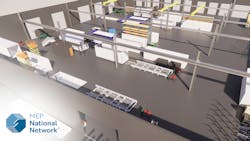All these reasons have forced many facility layout changes in the past few years. Afterall, the layout of physical space defines how one goes about their work.
Facility layout projects take a while to plan and execute, creating an economic “stickiness” to them. The benefits of a good facility layout are felt for a long time, making them among the most impactful initiatives for manufacturers. The risk of a bad layout can also have lasting effects. It follows that bringing in a fresh set of eyes to give an outsider’s perspective to your operation can result in a better overall layout when the project is finished.
A facility layout change should always start with Lean. Indeed, layout changes are often an outgrowth of an effective lean implementation. These two Lean tools are essential elements for success in any facility project:
- Root cause analysis: Your pre-work should include value stream mapping (VSM) to document how materials move, staffing at workstations, work balancing, work sequence, and causes of bottlenecks and downtime. The VSM will help identify wastes and opportunities for efficiency, while using the current process as a model for making decisions about layout changes.
- Continuous Improvement mindset: A new layout is a great opportunity to change how the work is done – take the opportunity and make the most of it. A culture of CI empowers employees to continue to look for ways to improve, no matter how small, even when production is operating smoothly. In every layout we’ve done, we always go in with notions of how it will look, some of which are ultimately abandoned for better ideas of how to do the layout.
Let’s look at four signs that it might be time to rethink your manufacturing facility layout.
1. You Are Embarking on a Capital Project for New Equipment
Manufacturing companies regularly find themselves in the position of adding new equipment, upgrading existing equipment or shifting from manual processes to automated machinery. Whatever the case may be, when it’s time to move equipment around, and put the new machines in, the operations department has an opportunity to be thoughtful about where those pieces will go. The key to a good layout is to do as much planning and analysis as possible ahead of the move to intentionally engineer how layout changes will impact each aspect of operation.
The plan to integrate new equipment begins with the operator who will work on the equipment. Talk through each of the interactions with the equipment. How will they do the maintenance on it? How will raw material flow to it and away from it? Is the height of the equipment going to create problems with sprinkler lines, fire code regulations, crane hooks, or existing structure? Going through this level of detail is the key exercise for catching the details that are important to consider before investing financial resources.
Examples of some changes that might need to happen in the facility include:
- New electrical connections
- Compressed air routed to the new equipment
- Adding floor drains for washing or draining condenser lines
- Bolting down equipment for seismic safety
- Cutting the floor to add utilities or to set equipment sub grade
These kinds of disruptions present an opportunity to move around other pieces while production is down. Small changes about how new equipment is installed can have big impacts on how operators interact with the new equipment.
2. You Know You Will Be More Efficient If You Change the Layout
This is a workflow-based update, often addressing what everyone in the operation knows: “We’d be more efficient if we change to this new layout.” This can be a significant step for a couple of reasons: You can often bring existing equipment together without a big capital investment, and first moves begat other moves.
Even if a pain point seems to be an obvious hindrance in the operation, it still is important to determine the root case. Here are three scenarios that might call for a facility layout modification:
- Layout problems show up with inventory piles on the facility floor
- The work is unbalanced between stations
- There isn’t “flow” to the operation. An example might be that subassemblies are transferred using carts from station to station, where a conveyor might be a good solution.
3. You Have Reached Capacity in Your Current Setup
You feel as if you have reached your current production capacity in this facility layout, with the current level of staffing, schedule, and tooling. But capacity is not always a facility issue; it could be many other factors.
One success story involves an Oregon manufacturer assembling a luxury consumer product. Their process had 28 workstations snaking through its facility, including several points where flawed products had been pulled from the workflow and were piling up. They embarked on a $1 million project to create a more efficient assembly line. The key metric was cycle time. The company squeezed an extra 50% production in the same space with the same overhead. They paid off the facility costs in a matter of weeks and grew annual revenue from about $50 million to $75 million, as demand for their product surged during the pandemic.
Continuous improvement played a key role as they instituted new standards for what it took to remove flawed products from the line, which put the onus on chasing quality issues up the line. There were also significant challenges in getting the condensed workflow ironed out, but the commitment to the initiative provided incentives for the staff to figure out.
4. Growth Opportunities Will Require Changes of Some Kind
You may be moving into a new facility and are not sure about how to utilize the space. Or you might be expanding your current space to meet growing demands or taking on a new product or customer. If the business needs to add 20% more capacity, then first consider adding labor and shifts. When the business needs to add more than 50% capacity it will likely need more equipment, sometimes a change to the process, and will no doubt need to make capital investments.
Growth presents a series of challenges, so it is important to make financial projections to validate any capital investment. Where a big financial investment is needed to grow the business, and there is risk or uncertainty about growth, it is helpful to build a financial model that projects how fixed and variable costs scale with the business, the effects of capital investments, labor cost changes, raw material changes and so forth.
The importance of having an efficient facility layout increases as you scale your business. Your facility layout can be an asset that positions you for profitable growth or magnifies your inefficiencies.
Important Considerations for Your Facility Layout Assessment
Best practices for a facility layout initiative include:
- Don’t underestimate the power of 3D drawings and visuals. Everyone can visualize a layout in 3D.
- Be clear on constraints that will bind the creativity of the perfect layout, such as timeline, budget, and physical limitations.
- Leverage front-line workers:
- You will learn about work arounds outside of your documented standard of work procedures
- They will have added incentive to make any changes work
- Manufacturing employees are good problem solvers
A Fresh Perspective Can Help You with a Facility Layout Modification
Facility layout evaluations and modifications are complicated initiatives. They require the expertise of process consultants, engineers, and architects. But facility reviews can be highly effective because they get into the details of many facets of the business and operations. They potentially engage executives and staff members doing the work on the facility floor.
Your local MEP Center experts have access to the resources that can help you with your facility layout considerations. Let us help you get started.
About the author
Justin Gradek is a Senior Consultant for OMEP, part of the MEP National Network. He analyzes systems and business processes and specializes in technology adoption, including facility re-layout and virtual and augmented reality.

